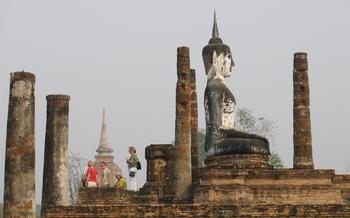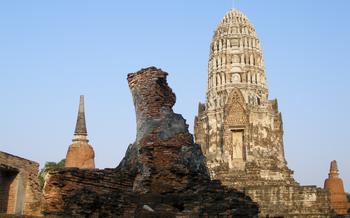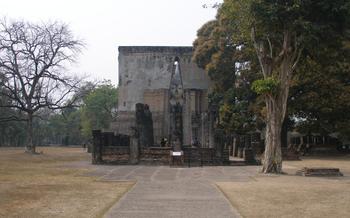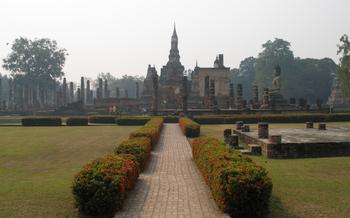
Wat Krieng Krai Klang
- History of Wat Krieng Krai Klang
- The Ordination Hall
- Buddha Images
- The Vihara
- Temple Grounds
- Wat Krieng Krai Klang Festival
- Monks' Quarters: A Glimpse into Monastic Life
- Ordination Ceremony
- Local Pilgrimages
- Community Involvement
- Temple Etiquette:
- Accommodation Nearby:
- Getting There
- Insider Tip:
History of Wat Krieng Krai Klang
Wat Krieng Kra Sawan, Thailand, holds a significant place in the region's religious and cultural heritage. Founded in 1845 by Venerable Luang Pu Yiam, a revered monk renowned for his spiritual teachings and devotion, the temple has stood as a beacon of faith for generations.
The architectural style of Wat Krieng Krai Klang showcases a harmonious blend of traditional Thai and Chinese elements, reflecting the diverse cultural influences that have shaped Nakhon Sawan. Intricate carvings, vibrant murals, and graceful stupas adorn the temple's structures, creating a visually stunning ensemble that captivates visitors.
Throughout its history, Wat Krieng Krai Klang has served as a center for religious devotion, spiritual guidance, and community gatherings. The temple's sacred grounds have borne witness to countless ceremonies, festivals, and acts of worship, strengthening the bonds of faith among the local populace.
The Ordination Hall
The ordination hall, or Bot, is the most significant structure within the Wat Krieng Krai Klang temple complex. It serves as a sacred space for the initiation of young men into the Buddhist monkhood. The hall is adorned with intricate murals and artwork that depict stories from the life of Buddha and other important Buddhist teachings. The wooden carvings that embellish the hall's interior are particularly noteworthy, showcasing the exceptional craftsmanship of Thai artisans.
One of the most striking features of the ordination hall is the series of murals that line the walls. These murals depict scenes from the Jataka Tales, which are stories about the previous lives of Buddha. The murals are a testament to the artistic skill and devotion of the temple's creators and serve as a visual guide to the teachings of Buddhism.
The ordination hall is also home to a number of important Buddha images, including a large bronze statue of the seated Buddha. This statue is considered to be the most revered image in the temple and is often the focus of religious ceremonies and rituals. The ordination hall is a place of great spiritual significance for Buddhists, and it is a must-see for anyone interested in learning more about the religion.
Buddha Images
Wat Krieng Krai Klang is renowned for the variety of Buddha images it houses within its walls. These statues, each with unique characteristics and historical significance, draw devotees and visitors alike. Among the most revered is Luang Pho Khao, an ancient Buddha image believed to have been created during the Sukhothai period. Crafted from bronze, Luang Pho Khao exudes a serene aura with intricate details and a gentle smile. Pilgrims often pay homage to this sacred image, offering prayers and seeking blessings.
Other notable Buddha images include Phra Chao Tan Jai, a large seated Buddha, and Phra Si La, a smaller standing Buddha. These statues represent different mudras, or hand gestures, and embody various aspects of Buddha's teachings. Visitors can marvel at the artistry and craftsmanship of these sacred figures, each representing a unique expression of devotion and faith.
Religious practices and rituals associated with the Buddha statues play a vital role in the daily life of the temple. Monks and devotees offer prayers and make offerings, such as flowers, candles, and incense, to pay homage to the Buddha and seek guidance and protection. These practices reflect the deep reverence and devotion that the Thai people have for Buddha and his teachings.
The Vihara
The vihara, a spacious and serene hall within the temple complex, serves as a gathering place for monks and laypeople alike. This multipurpose hall is used for various religious ceremonies, meditation sessions, and community meetings. The interior of the vihara is adorned with intricate murals depicting scenes from the life of Buddha and his teachings. These colorful paintings offer a visual narrative of Buddhist philosophy and history.
One notable feature of the vihara is the presence of numerous Buddha images, each with its unique characteristics and significance. Visitors can pay their respects and offer prayers to these sacred figures, seeking blessings and guidance. The vihara also hosts traditional festivals and ceremonies throughout the year, bringing together the local community to celebrate and honor their shared Buddhist heritage.
Temple Grounds
At Wat Krieng Krai Klang, the temple grounds are adorned with lush gardens, serene ponds, and a tranquil atmosphere. Visitors can stroll through the verdant pathways, taking in the beauty of the vibrant flora and the calming sound of water features. The sacred Bodhi tree, a revered symbol of enlightenment in Buddhism, stands majestically within the temple grounds, offering a sense of peace and spirituality. Visitors can sit beneath its shade, meditate, and reflect on the teachings of Buddha. Throughout the year, the temple grounds host cultural events and festivals that showcase traditional Thai customs and religious practices. These events provide opportunities for visitors to immerse themselves in the local culture and connect with the community.
Wat Krieng Krai Klang Festival
The Wat Krieng Krai Klang Festival is an annual event that draws a multitude of visitors to the temple. This vibrant festival, commonly called the temple fair, is held to celebrate the temple's founding and showcase the rich cultural heritage of the local community. During the festival, the temple grounds are transformed into a lively marketplace filled with stalls offering a variety of local delicacies, handmade crafts, and souvenirs.
The festival is a spectacle of music, dance, and traditional performances that showcase the vibrant Thai culture. Visitors can enjoy lively parades with colorful floats, energetic Muay Thai demonstrations, and graceful Thai dance performances. The highlight of the festival is the merit-making ceremony, where devotees offer food and other offerings to the monks to express their gratitude and seek blessings.
Participating in the Wat Krieng Krai Klang Festival offers a unique opportunity to immerse oneself in the local culture, interact with the friendly monks, and partake in the joyous festivities. It's a wonderful time to experience the temple's vibrant energy, connect with the local community, and create lasting memories.
Monks' Quarters: A Glimpse into Monastic Life
Within the serene confines of Wat Krieng Krai Klang, a dedicated space known as the monks' quarters offers a rare glimpse into the daily lives of the resident monks. These humble dwellings, often simple and modest, provide a sanctuary for contemplation, study, and spiritual growth.
The monks' quarters at Wat Krieng Krai Klang are typically arranged in a cluster of small, individual cells or rooms, each housing one or two monks. These cells are basic and unadorned, reflecting the principle of simplicity and detachment from worldly possessions. A thin mat for sleeping, a low wooden table for study, and a few personal belongings comprise the meager furnishings of each cell.
The daily routine of the monks begins early, as they rise before dawn for meditation and chanting. They spend their mornings studying Buddhist scriptures, attending to temple duties, and engaging in various forms of spiritual practice. The afternoons are often dedicated to community service, such as teaching or providing guidance to visitors.
Meals for the monks are simple and vegetarian, consisting of rice, vegetables, and fruits. They observe a strict code of conduct, adhering to the principles of non-violence, compassion, and generosity. Their lives are dedicated to the pursuit of enlightenment and the service of others, embodying the essence of Buddhist teachings.
A visit to the monks' quarters at Wat Krieng Krai Klang offers a unique opportunity to witness the simplicity and devotion of monastic life. Visitors are welcome to interact with the monks, asking questions and seeking guidance on spiritual matters. This interaction provides a deeper understanding of Buddhism and the role of monks in Thai society.
Ordination Ceremony
At Wat Krieng Krai Klang, ordination ceremonies are conducted with great solemnity and adherence to Buddhist traditions. Young men who aspire to enter monkhood undergo a rigorous process before they are officially ordained as monks. The ceremony typically takes place during the Buddhist Lent period, which falls between July and October.
During the ordination ceremony, the candidates are first required to shave their heads and eyebrows, symbolizing their renunciation of worldly attachments. They then don white robes, representing purity and detachment. The ceremony is presided over by a senior monk, who leads the candidates through a series of vows and precepts. These vows include abstaining from harming living beings, stealing, sexual misconduct, lying, and consuming intoxicants.
Once the vows have been taken, the candidates are officially ordained as monks and given their new monastic names. They then embark on a journey of spiritual development, studying Buddhist teachings, practicing meditation, and observing the monastic code of conduct. Wat Krieng Krai Klang plays a significant role in the ordination tradition, providing a sacred space for young men to embark on their monastic journey.
Local Pilgrimages
Wat Krieng Krai Klang holds significant importance as a pilgrimage site for devoted Buddhists in Thailand and beyond. Pilgrims from various regions embark on journeys to the temple, seeking spiritual fulfillment, blessings, and a deeper connection with their faith. The sacred atmosphere of the temple, coupled with the presence of revered Buddha images and relics, makes it a popular destination for religious devotees.
Pilgrims often visit Wat Krieng Krai Klang to pay homage to Luang Pho Khao, the most revered Buddha statue within the temple. Legend has it that this image was discovered floating down the Yom River and was subsequently enshrined at Wat Krieng Krai Klang. Devotees believe that Luang Pho Khao possesses miraculous powers and seek his blessings for good fortune, health, and protection.
The temple also attracts pilgrims during significant religious festivals and events. One notable occasion is the annual Wat Krieng Krai Klang Festival, held to commemorate the temple's founding. This vibrant festival features colorful processions, traditional performances, and chanting of sacred mantras. Pilgrims participate in these festivities to express their devotion and receive blessings from the temple's monks.
For many pilgrims, visiting Wat Krieng Krai Klang is an opportunity to deepen their understanding of Buddhism and its teachings. They engage in meditation and prayer, seeking spiritual guidance and wisdom from the temple's resident monks. The temple also serves as a place for pilgrims to learn about Buddhist history, culture, and traditions.
Through their pilgrimages to Wat Krieng Krai Klang, devotees not only seek spiritual fulfillment but also forge connections with fellow believers and contribute to the preservation of Buddhist heritage. The temple's significance as a pilgrimage site underscores its vital role in fostering religious devotion and strengthening the bonds within the Buddhist community.
Community Involvement
Wat Krieng Krai Klang plays a pivotal role in fostering community ties and contributing to the well-being of the local population. The temple serves as a central gathering place for various social events and gatherings, creating a sense of community and belonging among the residents.
The monks at Wat Krieng Krai Klang are actively involved in organizing and participating in these events, which range from religious ceremonies to cultural festivals and celebrations. These events provide opportunities for the local community to come together, strengthen their bonds, and share their traditions.
Additionally, the temple is committed to supporting education and healthcare within the community. The monks offer teachings and guidance on Buddhist principles and values, as well as practical knowledge and skills that benefit the local residents. The temple also provides assistance to those in need, offering food, shelter, and medical care to the underprivileged.
Through their compassionate actions and dedication to the community, the monks at Wat Krieng Krai Klang embody the Buddhist teachings of kindness, generosity, and service. Their efforts contribute to the overall well-being and harmony of the local society, making the temple an integral part of the community fabric.
Temple Etiquette:
Respecting the sacred atmosphere of Wat Krieng Krai Klang is essential for a fulfilling visit. Visitors are expected to dress appropriately, with shoulders and knees covered. Revealing attire is not permitted. When entering the temple grounds, remove your shoes and place them neatly on the designated racks.
Mindful behavior is crucial to maintain the tranquility of the temple. Loud noises and conversations should be avoided. Visitors should refrain from pointing their feet towards Buddha images, as this is considered disrespectful. Instead, a slight bow is a customary way to show reverence.
Photography is generally permitted within the temple complex, but it's important to be mindful of other visitors and avoid taking flash photography. Ask permission before photographing monks, as they may prefer privacy. By following these simple guidelines, visitors can demonstrate respect for the local customs and traditions, ensuring a harmonious and enriching experience for all.
Accommodation Nearby:
When planning your visit to Wat Krieng Krai Klang, consider staying in the vicinity to make the most of your temple experience. Several guesthouses and hotels offer comfortable accommodations within a short distance from the temple.
For budget-conscious travelers, the Wat Krieng Krai Klang Guesthouse is an excellent option. Located just steps away from the temple, this simple guesthouse provides basic but clean rooms at affordable rates. The friendly staff can assist with any inquiries or needs you may have.
If you prefer a more upscale experience, the Nakhon Sawan Palace Hotel is a great choice. Situated about 10 minutes away by tuk-tuk, this modern hotel offers spacious rooms, a swimming pool, and a fitness center. The hotel staff can arrange temple tours and other activities upon request.
No matter your budget or preferences, there are plenty of accommodation options near Wat Krieng Krai Klang to suit your needs. Remember to book your stay in advance, especially during peak tourist season, to secure a comfortable place to rest and recharge after your temple visit.
Getting There
Reaching Wat Krieng Krai Klang from Bangkok is a breeze, with several transportation options available to suit your preferences and budget. For a cost-effective and scenic journey, hop on a bus from Bangkok's Northern Bus Terminal (Mo Chit). The buses depart regularly and take approximately 4 hours to reach Nakhon Sawan. Once in Nakhon Sawan, you can take a local bus or taxi to the temple, which is conveniently located just a few kilometers from the city center.
If you prefer a more comfortable and flexible option, consider hiring a taxi or renting a car. The drive from Bangkok to Nakhon Sawan takes about 3 hours, and the roads are generally well-maintained. Once you arrive in Nakhon Sawan, follow the signs to Wat Krieng Krai Klang or ask for directions from locals.
No matter which mode of transport you choose, be sure to plan your trip in advance, especially if you're visiting during peak tourist season. Check bus schedules, book your tickets online, or arrange for a reliable taxi service to avoid any last-minute surprises.
Insider Tip:
-
Explore the Hidden Gems: While visiting the temple, take time to venture into the secluded corners of the complex. Discover the hidden stupas and meditation caves tucked away in the serene gardens. These tranquil spots offer a unique opportunity for introspection and spiritual connection.
-
Capture the Essence: Wat Krieng Krai Klang presents a myriad of photographic opportunities. Capture the intricate details of the temple's architecture, the serene beauty of the lotus ponds, and the colorful murals adorning the walls. Remember to ask permission from the resident monks before photographing them or any religious ceremonies.
-
Attend a Special Event: Plan your visit during one of the temple's many festivals or special events. These celebrations, like the annual Wat Krieng Krai Klang Festival, offer a vibrant glimpse into local traditions and culture. Engage with the local community, participate in lively processions, and experience the temple's energy at its peak.






